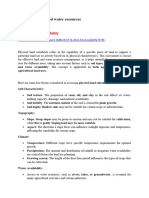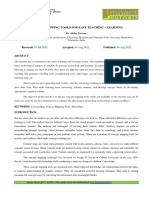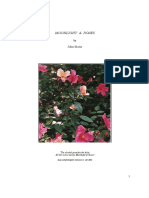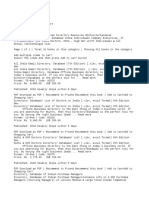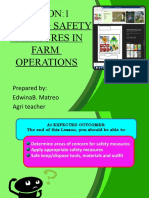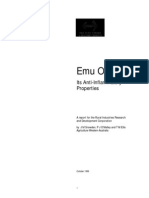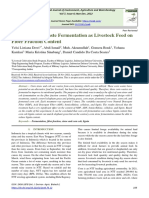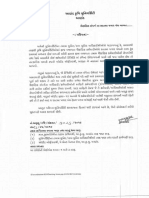Watershed Management - A Gis Approach
Watershed Management - A Gis Approach
Uploaded by
Impact JournalsCopyright:
Available Formats
Watershed Management - A Gis Approach
Watershed Management - A Gis Approach
Uploaded by
Impact JournalsOriginal Title
Copyright
Available Formats
Share this document
Did you find this document useful?
Is this content inappropriate?
Copyright:
Available Formats
Watershed Management - A Gis Approach
Watershed Management - A Gis Approach
Uploaded by
Impact JournalsCopyright:
Available Formats
IMPACT: International Journal of Research in Applied,
Natural and Social Sciences (IMPACT: IJRANSS)
ISSN (P): 2347-4580; ISSN (E): 2321-8851
Vol. 4, Issue 6, Jun 2016, 109-116
Impact Journals
WATERSHED MANAGEMENT - A GIS APPROACH
RAJEEV1 & SULTAN SINGH2
1
2
Research Scholar, Department of Geography, Kurukshetra University Kurukshetra, India
Senior Scientist, Department of Science & Technology, HARSAC, Goverment. of Haryana, India
ABSTRACT
Watershed management decision making is a complex process. Cooperation and communication among federal,
state, and local stakeholders is required while balancing biophysical and socioeconomic concerns. The public is taking part
in environmental decisions, and the need for technology transfer from public agencies to stakeholders is increasing.
Information technology has had a profound influence on watershed management over the past decade. Advances in data
acquisition through remote sensing, data utilization through geographic information systems (GIS), and data sharing
through the Internet have provided watershed managers access to more information for management decisions. In the
future, applications incorporating hydrologic simulation models, GIS, and decision support systems will be deployed
through the Internet. In addition to challenges in making complex modelling technology available to diverse audiences,
new information technology issues, such as interoperability, Internet access, and security, are introduced when GIS,
simulation models, and decision support systems are integrated in an Internet environment.
KEYWORDS: Watershed Management, Information Technology, Internet, Geography, Geographical Information
Systems, Spatial Analysis
INTRODUCTION
Watershed management decision making is inherently complex. It requires cooperation with federal, state, and
local bodies while incorporating biophysical and socioeconomic process. Traditionally, transfer of information was
unidirectional, typically from state of federal government agencies to landowners. in today's society, bidirectional
communication is imperative, expanding the role of land management agencies in the decision making process. However,
federal and state budgets are increasingly constrained, and new techniques' for information transfer need to be employed.
Watershed management decisions are further complicated by both the complexity of the issues and those processes
creating the problems. the difficulties in spatially representing and quantifying biophysical and socioeconomic process
require that management decisions be based on imperfect information. Water is life, in all forms and shapes. This basic yet
profound truth eluded many of us in the second half of the 20th century. Water professionals and scientists around the
world are ringing the alarming bells of an impending water crisis. Yet attempts to address some of the issues or to offer
partial solutions met with limited success. The ever-growing population and concomitant expansion of agriculture and
industry have placed increasing demand on the limited water resources (Department of Land Resources).
"There is a water crisis today. But the crisis is not having too little water to satisfy our needs. It is a crisis of
managing water so badly that billions of people and the environment"
suffer badly" (World Water Council, 2000)
Impact Factor(JCC): 2.7341 - This article can be downloaded from www.Impactjournals.us
110
Rajeev & Sultan Singh
OBJECTIVE
The objectives of the study are as follows:
To Study the process of watershed management system through Remote Sensing and GIS.
SCHEMATIC REPRESENTING PROCESS IN THE GLOBAL HYDROLOGICAL CYCLE
The interdependence and continuous movement of all forms of water on the earth and in the atmosphere is known
as hydrologic cycle. The hydrologic cycle can also be defined as the processes and pathways involved in the circulation of
water from land and water bodies (sea, rivers, lakes etc.) to the atmosphere and back again.
Figure 1: Shows the Global Hydrological Cycle
Definition of Watershed
It is defined as the land area from which water drains to a given point. In other words watershed is an area from
which runoff, resulting from precipitation, flows past a single point into a stream. Since water is drained off to a given
point. The management of watershed in point of view of Hydrology is easily possible. Hence, we can arrive to another
definition of watershed i.e. "watershed is a manageable Hydrological Unit".
Figure 2: Shows the Delineation of Watershed
Watershed can be delineated using topographic maps with help of drainage lines which represents the ridge and
valleys
Index Copernicus Value: 3.0 - Articles can be sent to editor@impactjournals.us
Watershed Management - A GIS Approach
111
Figure 3: (1) Ridge Line (2) Valley line (3) Ridges and Valleys in a watershed
Table 1: List of Watershed Characteristics, How to Derive them and Why it is Required
Source: Ministry of Land Resources, Government of Andhra Pradesh
What is Watershed Management?
Watershed management means the rational utilization of land and water resources of watershed for optimal
production with minimal hazard to natural resources. Watershed- based management is the most effective way to enhance
water quality and natural resources, protect critical terrestrial and aquatic habitat, prevent soil erosion, and sustain
Impact Factor(JCC): 2.7341 - This article can be downloaded from www.Impactjournals.us
112
Rajeev & Sultan Singh
resource-based economic activities while concurrently managing the pressures of an increasingly urbanized landscape.
Importance of Watershed Management in the Present Scenario
Watershed management or protection implies the proper use of all land and water resources of a watershed for
optimum production with minimum hazard to natural resources. The different objectives of a watershed management
programme are:
To control damaging runoff
To manage and utilize runoff for useful purposes
To control erosion and effect reduction in the sediment production
To moderate floods in the downstream areas
To enhance ground water storage wherever applicable
Appropriate use of land resources in the watershed and thus developing forest and fodder resources. Adoption of
conservation farming practices to improve agriculture, controlled grazing to keep the pastures productive, water
management for irrigation and drainage and all other types of erosion control measures could be each watershed are
different and program for their management could also be different. Inappropriate land use practices in the upstream
catchment leads to accelerated soil erosion and consequent silting up of reservoirs. Watershed management in thus an
integral part of any water resources project. The prioritization of watershed i.e. which needs to be paid attention is based on
sediment yield potential so that the treatment would result in minimizing sediment load into the reservoir.
Watershed Characterisation using Remote Sensing and GIS
Various watershed characteristics required for watershed management can be derived using remote sensing and
GIS. A brief description is given here.
Size: This characteristic determines the quantity of precipitation received, retained and drained off. Small
watershed behaves differently from the large ones in terms of the relative importance of various phases of the
runoff phenomenon. This can be delineated using the topographic maps (first instance), by the concept of ridge
and valley lines (as explained previously), based on the position of the watershed outlet. The area of the watershed
can be digitized using GIS functions. This boundary can be verified with the help of the aspect map, which can be
derived using DEM, using any standard GIS function.
Shape: Watersheds have many shapes e.g. it could be rectangular, square, palm shape, oval etc. The shape
controls the length, width ratio which affects the runoff characteristics. For example, the longer the watershed, the
greater is the time of concentration. The longer the time of concentration, the greater the time available for the
water to infiltrate, evaporate and get utilized by vegetation. Shape of watershed is the output of watershed
boundary delineated in GIS environment.
Slope: This is a very important characteristics of a watershed. It affects the time of concentration, infiltration
opportunity time, and runoff and soil loss. Slope can be derived in GIS environment using DEM. Using the
watershed boundary, the weighted average slope of the watershed can be derived in a GIS environment.
Index Copernicus Value: 3.0 - Articles can be sent to editor@impactjournals.us
Watershed Management - A GIS Approach
113
Drainage: This is another important factor which influences the watershed behavior. A large drainage density
(length of drainage channels per unit area) creates situation conducive for quick disposal of runoff down the
channels. In watershed where drainage density is less overland flow is predominant. Length of the channels can be
derived using the digitized drainage in GIS environment.
Geology: Nature of parent rocks, features, faults, extent of outcrops and weathering can be known by
interpretation of satellite data and also ground truth collected. It is possible to understand the ground water
recharge areas also, using the geomorphology and analysis of other relevant information.
Soils: Major soil groups of the watershed and their hydrologic groupings. Physical and chemical properties as
required, which can derived using the mapping of physiographic units from the satellite data and combined with
the field verification of soil profiles dug in each of the physiographic units.
Climate: Precipitation, its annual, seasonal and monthly distribution, forms of precipitation, storm pattern,
rainfall intensity and duration are to be collected from metrological stations. Their spatial distribution can be
understood in a GIS environment. Other climatic factors include air temperature (min. and max.), soil
temperature, evaporation, relative humidity, wind velocity, wind direction, and solar radiation are also required
for understanding the hydrology of the area. If necessary, these data can be converted into spatial data using GIS
functions.
Surface Condition and Landuse : Existing land use and cover conditions including forest lands, range lands,
cultivated lands, waste lands, habitations and miscellaneous uses can be derived using interpretation of satellite
images and also ground truth. Forest type and area under each classification (like stock forest, degraded forest,
scrub etc. hydrologic conditions, legal status (reserved, demarcated, protected, un demarcated, protected,
unclassified, private, community etc.) can be obtained from remote sensing images. Extent of agricultural lands,
land capability classification, area under each class and subclass, area under irrigation, major crops, rain fed area
along with crops grown, orchards and their extent etc. can be obtained by interpretation of remote sensing data
and collection of ground truth.
Ground Water: Source of ground water and ground water levels during pre-monsoon and postmonsoon conditions are necessary to understand extent of ground water-recharge and possible quantity available
for utilization.
Economic Data : General economic conditions of the people, important professions and their dependence on
watershed resources, markets and marketing practices, return from forests including fire wood, and minor forest
products, return from range land, grazing value, returns from cultivated land including irrigated and rain fed etc.
Texture: Textures Provide Important: characteristics for the analysis of many types of images including natural
scenes, remote sensing data and biomedical modalities. The perception of texture is believed to play an important
role in human visual system for reorganization and interpretation. Pervious method of analysis for accomplishing
texture classification may be roughly divided into three categories : statistical, structural and spectral.
Impact Factor(JCC): 2.7341 - This article can be downloaded from www.Impactjournals.us
114
Rajeev & Sultan Singh
Watershed Management
Concept of Watershed Management: The concept of Watershed Management is shown pictorially with various
aspects which need to be considered, as the sentiments of the people living within the watershed area have to be given
utmost priority in implementing various watershed management schemes.
Aims of Watershed Management
To control damaging runoff.
To control erosion & sediment yield.
To moderate flood.
To enhance ground water storage.
To use land resources optimally.
To protect, conserve, & improve lands.
To develop & mange water resources.
Figure 4: Shows Watershed Management
PROBLEMS IN WATERSHED MANAGEMENT PROGRAMME
Professional Problems
Identifying existing problems
Convincing concerned authority
Defining local requirements
Index Copernicus Value: 3.0 - Articles can be sent to editor@impactjournals.us
Watershed Management - A GIS Approach
Selecting proper management practice
Designing & implementation
115
Social Problems
Low awareness
Reluctance to change existing practices
Poor participation of locals
Feudal social structure
Financial Problems
Psychological Problems
Role of Geoinformation Technology
Satellite data have been extensively used in many watershed All India Soil and Landuse Survey, Ministry of
Agriculture, Government of India. Space borne multispectral data have been used to generate baseline information on
various natural resources, namely soils, forest cover, surface water, ground water and land use/ land cover and subsequent
integration of such information with slope and socio- economic data in a Geographic Information System (GIS) to
generate locale-specific prescription for sustainable development of land and water resources development on a watershed
basis.
CONCLUSIONS
Watershed Management has assumed urgency for planned development of land and water resources and to arrest
land degradation process to preserve environment and ecological balance. Decision support to such management planning
requires scientific knowledge of resources information, expected runoff and sediment yield, priority classification of
watersheds for conservation planning, monitoring of watershed for environmental impact assessment and technologies of
GIS for data base creation, scenario development and appropriate decision making. Remote sensing technique is ideally
suited to evolve such a management strategy. Scientific basis of this approach is explained.
REFERENCES
1.
Department of Land Resources, Guidelines for Hariyali. http://dolr.nic.in/Hariyali Guidelines.htm. DOLR,
(Ministry of Rural Development, Government of India, New Delhi, India, 2003).
2.
Government of India, Common Guidelines for Watershed Development Projects. National Rain-fed Area
Authority (Ministry of Land Resources, Government of Andhra Pradesh, India. 57, 2001).
3.
R. Sharma, Watershed Development Adaptation Strategy for Climate Change. (Paper presented in South Asia
expert workshop on Adaptation to Climate Change for Agricultural Productivity, organized by the Government of
India, UNEP and CGIAR, New Delhi, 2002).
4.
E. T. Engman, R. J. Gurney, Remote Sensing in Hydrology (Chapman and Hall India, 1991).
Impact Factor(JCC): 2.7341 - This article can be downloaded from www.Impactjournals.us
116
Rajeev & Sultan Singh
5.
Integrated Mission for Sustainable Development report, (NRSA, India, 2003).
6.
P. Suhas Wani, Principal Scientist (Watersheds) and Regional Theme Coordinator (Asia), Global Theme on
Agroecosystems (ICRISAT, Patancheru 502 324, Andhra Pradesh, India).
7.
Benjamin Kumpf, Communication Specialist, Global Theme on Agroecosystems (ICRISAT, Patancheru 502 324,
Andhra Pradesh, India).
8.
V.P. Mehta, S.K. Sharma, Chandigarh- The City Beautiful (Vishvas Publications Pvt. Ltd. - 167 Industrial Area,
Phase -2, Chandigarh, 1996).
Index Copernicus Value: 3.0 - Articles can be sent to editor@impactjournals.us
You might also like
- Grade EasyDocument42 pagesGrade Easylouisprice100% (1)
- Chapter 4.2. Grow-Out Culture of High Value Species in Pond PDFDocument12 pagesChapter 4.2. Grow-Out Culture of High Value Species in Pond PDFNiño Jess Mar MechaNo ratings yet
- Application of Geospatial Techniques For Hydrological ModellingDocument12 pagesApplication of Geospatial Techniques For Hydrological ModellingInternational Journal of Multidisciplinary Research and AnalysisNo ratings yet
- Hydrological Modeling Nullah LaiDocument12 pagesHydrological Modeling Nullah LaiBashir AhmadNo ratings yet
- Hydrologic Analysis 1Document6 pagesHydrologic Analysis 1Alex Ramos ChoquehuancaNo ratings yet
- Remotesensing 02 02274 v2 PDFDocument31 pagesRemotesensing 02 02274 v2 PDFBtph MoiNo ratings yet
- Khaing Chan Myae Thu-Journal.4 PDFDocument8 pagesKhaing Chan Myae Thu-Journal.4 PDFKhaing Chan Myae ThuNo ratings yet
- Urban Flood Nazaf (17113075)Document6 pagesUrban Flood Nazaf (17113075)Nazaf AhzamNo ratings yet
- Research Proposal PHDDocument19 pagesResearch Proposal PHDSuleiman Mukhtar100% (2)
- Unit 4Document22 pagesUnit 4GEO1903 Jagadeesh SNo ratings yet
- Applications of GIS in Water ResourcesDocument19 pagesApplications of GIS in Water ResourcesBhargav YandrapalliNo ratings yet
- Panzara River Watershed Prioritization Based On Geomorphometric and LULC Change Analysis Using Geo-Spatial TechniquesDocument17 pagesPanzara River Watershed Prioritization Based On Geomorphometric and LULC Change Analysis Using Geo-Spatial TechniquesInternational Journal of Innovative Science and Research TechnologyNo ratings yet
- Mangalam River Flood Map PDFDocument11 pagesMangalam River Flood Map PDFPearl Ellen Bumal-oNo ratings yet
- Seminar ReportDocument41 pagesSeminar ReportpoojaNo ratings yet
- Wre (Finals)Document17 pagesWre (Finals)Allyson DulfoNo ratings yet
- Remote Sensing in HydrologyDocument19 pagesRemote Sensing in Hydrologyadityaap0% (1)
- PHD OpportunityDocument3 pagesPHD OpportunityADAMU GAMBONo ratings yet
- ABEn 176-Lab 3-TribunaloDocument9 pagesABEn 176-Lab 3-TribunaloLormelyn TribunaloNo ratings yet
- Sediment Transport - 3Document13 pagesSediment Transport - 3Abdulkerim OumerNo ratings yet
- A Distributed Flood Inundation Model Integrating With Rainfall-Runoff Processes Using Gis and Remote Sensing DataDocument6 pagesA Distributed Flood Inundation Model Integrating With Rainfall-Runoff Processes Using Gis and Remote Sensing DatadequanzhouNo ratings yet
- Role of Hydrology and Hydraulics in Water Resource111Document40 pagesRole of Hydrology and Hydraulics in Water Resource111Alvin DeliroNo ratings yet
- PBL Ce5813Document7 pagesPBL Ce5813Rohit AdhikariNo ratings yet
- Application of GIS in WatershedDocument7 pagesApplication of GIS in Watershedቤኪ የአዲስ ልጅNo ratings yet
- Final ReportDocument20 pagesFinal ReportKimberly Binay-anNo ratings yet
- Flood Hazard Mapping in Dikrong Basin of Arunachal Pradesh IndiaDocument6 pagesFlood Hazard Mapping in Dikrong Basin of Arunachal Pradesh IndiaSajin B RajNo ratings yet
- Main PPT 2Document48 pagesMain PPT 2Ritesh Kumar ChitturiNo ratings yet
- Research Paper 2Document16 pagesResearch Paper 2pkjatNo ratings yet
- Floodplain Modelling Materials and MethodologyDocument4 pagesFloodplain Modelling Materials and MethodologyIDESNo ratings yet
- Climate Change Prediction and Adaptation in EcohydraulicsDocument5 pagesClimate Change Prediction and Adaptation in Ecohydraulicsandre talNo ratings yet
- Water: A Review of Roof and Pond Rainwater Harvesting Systems For Water Security: The Design, Performance and Way ForwardDocument22 pagesWater: A Review of Roof and Pond Rainwater Harvesting Systems For Water Security: The Design, Performance and Way ForwardMárcio OicramNo ratings yet
- Sponge Cities Emerging Approaches Challenges and Opportunities-5-2Document10 pagesSponge Cities Emerging Approaches Challenges and Opportunities-5-2Hector Alfredo Gutierrez RomeroNo ratings yet
- PDF PropDocument10 pagesPDF PropsetugeyesusNo ratings yet
- Signifying G.I.S and Remote Sensing in Watershed Management: Presented by Swati Aggarwal & Radhika GuptaDocument28 pagesSignifying G.I.S and Remote Sensing in Watershed Management: Presented by Swati Aggarwal & Radhika Guptachemcool123No ratings yet
- I Nternational Journal of Computational Engineering Research (Ijceronline - Com) Vol. 2 Issue. 7Document5 pagesI Nternational Journal of Computational Engineering Research (Ijceronline - Com) Vol. 2 Issue. 7International Journal of computational Engineering research (IJCER)No ratings yet
- Tools and Technologies For Water Resources Planning and Climate Change AdaptationDocument57 pagesTools and Technologies For Water Resources Planning and Climate Change AdaptationVitor Vieira VasconcelosNo ratings yet
- 46-Full Length Article-223-1-10-20180705Document18 pages46-Full Length Article-223-1-10-20180705cocochanbb31No ratings yet
- IJRAR23A2716Document9 pagesIJRAR23A2716Mohit nemadeNo ratings yet
- Freshwater KopiaDocument22 pagesFreshwater KopiaMaria KarasińskaNo ratings yet
- Integrated Groundwater Resources Management Using The Dpsir 2vj7zb0z3rDocument26 pagesIntegrated Groundwater Resources Management Using The Dpsir 2vj7zb0z3rromi designNo ratings yet
- Lecture 3-Hydrological Data For Watershed PlanningDocument20 pagesLecture 3-Hydrological Data For Watershed PlanningChu DicksonNo ratings yet
- Micro Watershed To Basin Scale Impacts of Widespread Adoption of Watershed Management Interventions in Blue Nile BasinDocument6 pagesMicro Watershed To Basin Scale Impacts of Widespread Adoption of Watershed Management Interventions in Blue Nile BasinZerihun AlemayehuNo ratings yet
- Do Remote Sensing Mapping Practices Adequately Address Localized Flooding? A Critical OverviewDocument17 pagesDo Remote Sensing Mapping Practices Adequately Address Localized Flooding? A Critical OverviewMagnum OpusNo ratings yet
- Watershed ManagementDocument17 pagesWatershed Managementali_loraineNo ratings yet
- Spatial Modelling of KnowledgeDocument15 pagesSpatial Modelling of KnowledgeEKNo ratings yet
- GIS Application in Watershed ManagementDocument7 pagesGIS Application in Watershed Managementjafar cad100% (1)
- Islamic Republic of IranDocument23 pagesIslamic Republic of IranzeeNo ratings yet
- WreDocument7 pagesWreS. M. FARZIN HASAN 1801078No ratings yet
- Modeling The Impact of Development Policies and Climate - 2021 - Landscape andDocument15 pagesModeling The Impact of Development Policies and Climate - 2021 - Landscape andImagine boyNo ratings yet
- Ijias 18 239 01Document14 pagesIjias 18 239 01Fabrice AdingraNo ratings yet
- Hydrograph Analysis: HydrologyDocument31 pagesHydrograph Analysis: HydrologyMaryll TapiaNo ratings yet
- Modder RiverDocument12 pagesModder RiverPisic_FluffyNo ratings yet
- WatershedDocument15 pagesWatershedterefa1234No ratings yet
- Hydrology Hdrology: Hydrology Created By: Engr. Aline Benneth V. JacoboDocument70 pagesHydrology Hdrology: Hydrology Created By: Engr. Aline Benneth V. JacoboRafael IlaganNo ratings yet
- Hydrology-Module 1-Phase 1Document11 pagesHydrology-Module 1-Phase 1Kristine DizonNo ratings yet
- Ijciet 06 10 004Document10 pagesIjciet 06 10 004IAEME PublicationNo ratings yet
- Urban Flood Depth Estimate With A New Calibrated Curve Number Runoff Prediction ModelDocument9 pagesUrban Flood Depth Estimate With A New Calibrated Curve Number Runoff Prediction ModelNur Shukria Hidayah HiulNo ratings yet
- Fullreport Hydro Group4Document39 pagesFullreport Hydro Group4muhammad hazeqNo ratings yet
- +JSTD 2015 V4N2 P02 CompressedDocument12 pages+JSTD 2015 V4N2 P02 Compressedcocochanbb31No ratings yet
- Bio Ecological Drainage SystemDocument0 pagesBio Ecological Drainage SystemanansamyNo ratings yet
- HYDROLOGYDocument25 pagesHYDROLOGYSurekha Abhishek Rao100% (1)
- Surface Water Evolution (2001-2017) at The Cambodia/Vietnam Border in The Upper Mekong Delta Using Satellite MODIS ObservationsDocument19 pagesSurface Water Evolution (2001-2017) at The Cambodia/Vietnam Border in The Upper Mekong Delta Using Satellite MODIS Observationsraphael sermetNo ratings yet
- Groundwater Prospecting: Tools, Techniques and TrainingFrom EverandGroundwater Prospecting: Tools, Techniques and TrainingNo ratings yet
- 12-11-2022-1668238142-6-Impact - Ijrbm-01.Ijrbm Smartphone Features That Affect Buying Preferences of StudentsDocument7 pages12-11-2022-1668238142-6-Impact - Ijrbm-01.Ijrbm Smartphone Features That Affect Buying Preferences of StudentsImpact JournalsNo ratings yet
- 19-11-2022-1668838190-6-Impact - Ijrhal-3. Ijrhal-A Study of Emotional Maturity of Primary School StudentsDocument6 pages19-11-2022-1668838190-6-Impact - Ijrhal-3. Ijrhal-A Study of Emotional Maturity of Primary School StudentsImpact JournalsNo ratings yet
- 19-11-2022-1668837986-6-Impact - Ijrhal-2. Ijrhal-Topic Vocational Interests of Secondary School StudentsDocument4 pages19-11-2022-1668837986-6-Impact - Ijrhal-2. Ijrhal-Topic Vocational Interests of Secondary School StudentsImpact JournalsNo ratings yet
- 14-11-2022-1668421406-6-Impact - Ijrhal-01. Ijrhal. A Study On Socio-Economic Status of Paliyar Tribes of Valagiri Village AtkodaikanalDocument13 pages14-11-2022-1668421406-6-Impact - Ijrhal-01. Ijrhal. A Study On Socio-Economic Status of Paliyar Tribes of Valagiri Village AtkodaikanalImpact JournalsNo ratings yet
- 12-10-2022-1665566934-6-IMPACT - IJRHAL-2. Ideal Building Design y Creating Micro ClimateDocument10 pages12-10-2022-1665566934-6-IMPACT - IJRHAL-2. Ideal Building Design y Creating Micro ClimateImpact JournalsNo ratings yet
- 09-12-2022-1670567569-6-Impact - Ijrhal-05Document16 pages09-12-2022-1670567569-6-Impact - Ijrhal-05Impact JournalsNo ratings yet
- 28-10-2022-1666956219-6-Impact - Ijrbm-3. Ijrbm - Examining Attitude ...... - 1Document10 pages28-10-2022-1666956219-6-Impact - Ijrbm-3. Ijrbm - Examining Attitude ...... - 1Impact JournalsNo ratings yet
- 19-09-2022-1663587287-6-Impact - Ijrhal-3. Ijrhal - Instability of Mother-Son Relationship in Charles Dickens' Novel David CopperfieldDocument12 pages19-09-2022-1663587287-6-Impact - Ijrhal-3. Ijrhal - Instability of Mother-Son Relationship in Charles Dickens' Novel David CopperfieldImpact JournalsNo ratings yet
- 22-09-2022-1663824012-6-Impact - Ijranss-5. Ijranss - Periodontics Diseases Types, Symptoms, and Its CausesDocument10 pages22-09-2022-1663824012-6-Impact - Ijranss-5. Ijranss - Periodontics Diseases Types, Symptoms, and Its CausesImpact JournalsNo ratings yet
- 21-09-2022-1663757902-6-Impact - Ijranss-4. Ijranss - Surgery, Its Definition and TypesDocument10 pages21-09-2022-1663757902-6-Impact - Ijranss-4. Ijranss - Surgery, Its Definition and TypesImpact JournalsNo ratings yet
- 29-08-2022-1661768824-6-Impact - Ijrhal-9. Ijrhal - Here The Sky Is Blue Echoes of European Art Movements in Vernacular Poet Jibanananda DasDocument8 pages29-08-2022-1661768824-6-Impact - Ijrhal-9. Ijrhal - Here The Sky Is Blue Echoes of European Art Movements in Vernacular Poet Jibanananda DasImpact JournalsNo ratings yet
- 25-08-2022-1661424544-6-Impact - Ijranss-6. Ijranss - Parametric Metric Space and Fixed Point TheoremsDocument8 pages25-08-2022-1661424544-6-Impact - Ijranss-6. Ijranss - Parametric Metric Space and Fixed Point TheoremsImpact JournalsNo ratings yet
- 06-08-2022-1659783347-6-Impact - Ijrhal-1. Ijrhal - Concept Mapping Tools For Easy Teaching - LearningDocument8 pages06-08-2022-1659783347-6-Impact - Ijrhal-1. Ijrhal - Concept Mapping Tools For Easy Teaching - LearningImpact JournalsNo ratings yet
- 24-08-2022-1661313054-6-Impact - Ijranss-5. Ijranss - Biopesticides An Alternative Tool For Sustainable AgricultureDocument8 pages24-08-2022-1661313054-6-Impact - Ijranss-5. Ijranss - Biopesticides An Alternative Tool For Sustainable AgricultureImpact JournalsNo ratings yet
- The Analysis On Environmental Effects of Land Use and Land Cover Change in Liuxi River Basin of GuangzhouDocument16 pagesThe Analysis On Environmental Effects of Land Use and Land Cover Change in Liuxi River Basin of GuangzhouImpact JournalsNo ratings yet
- What Is A GMODocument18 pagesWhat Is A GMOMichelle Anne OlivarNo ratings yet
- 6 FisheriesDocument28 pages6 FisheriesrajamehtabNo ratings yet
- Moonlight & Roses PDFDocument63 pagesMoonlight & Roses PDFTitu A FaNo ratings yet
- MotionDocument6 pagesMotionRobert willaimsNo ratings yet
- Lesson 1 Edwina MatreoDocument54 pagesLesson 1 Edwina MatreoOnin MatreoNo ratings yet
- 4 India Affordable HousingDocument26 pages4 India Affordable HousingPraveen StoneageNo ratings yet
- CpSci 101 - Module 5 - Lesson 3 and 4 Descriptive Classification & Agricultural ClasiificationDocument8 pagesCpSci 101 - Module 5 - Lesson 3 and 4 Descriptive Classification & Agricultural ClasiificationRegan Roldan RolaNo ratings yet
- Identification and Control of Fungi Associated With The Post-Harvest Rot of Solenostemon Rotundifolius (Poir) J.K. Morton in Adamawa State of Nigeria.Document6 pagesIdentification and Control of Fungi Associated With The Post-Harvest Rot of Solenostemon Rotundifolius (Poir) J.K. Morton in Adamawa State of Nigeria.Alexander DeckerNo ratings yet
- Emu Oil Its Anti-Inflammatory PropertiesDocument49 pagesEmu Oil Its Anti-Inflammatory PropertiesInstitut OrganicaNo ratings yet
- Wolfville School Science Fair 2012Document6 pagesWolfville School Science Fair 2012wolfvilleschoolNo ratings yet
- LBC No. 61 PDFDocument40 pagesLBC No. 61 PDFmelizze100% (9)
- Effect of Corn Waste Fermentation As Livestock Feed On Fiber Fraction ContentDocument5 pagesEffect of Corn Waste Fermentation As Livestock Feed On Fiber Fraction ContentMamta AgarwalNo ratings yet
- Rural Marketing AsssignDocument4 pagesRural Marketing AsssignTheLuckyOneNo ratings yet
- Preparation and Quality Characterization of Soy Milk Based Non-Dairy Ice CreamDocument7 pagesPreparation and Quality Characterization of Soy Milk Based Non-Dairy Ice CreamnabilahasnaNo ratings yet
- Introduction and Resources of Fish in IndiaDocument14 pagesIntroduction and Resources of Fish in IndiashraddhaNo ratings yet
- Alternatives For Processing of SoapstockDocument4 pagesAlternatives For Processing of SoapstockRafaela SantosNo ratings yet
- 22376-Article Text-74552-2-10-20181203 PDFDocument8 pages22376-Article Text-74552-2-10-20181203 PDFnurulNo ratings yet
- NAbard Model Bank ProjectsDocument44 pagesNAbard Model Bank ProjectsSrinivasan SakthivelNo ratings yet
- HP Ii 2-2Document16 pagesHP Ii 2-2arunalrnNo ratings yet
- INMATEH-Agricultural Engineering 46 2015Document191 pagesINMATEH-Agricultural Engineering 46 2015Popa LucretiaNo ratings yet
- American Pageant Chapter 5Document22 pagesAmerican Pageant Chapter 5carlosNo ratings yet
- Proto-Indo-European Aryan Homeland of The Great Mother Goddess: Neolithic Village of Tumba Madžari in Skopje, MacedoniaDocument11 pagesProto-Indo-European Aryan Homeland of The Great Mother Goddess: Neolithic Village of Tumba Madžari in Skopje, MacedoniaBasil ChulevNo ratings yet
- ULTRA HIGH DENSITY AND THE VALUE OF TRELLISING - A CASE STUDY OF MALUMA. Keywords - Practices, Production, Profitability, Pruning, Technique, YieldDocument17 pagesULTRA HIGH DENSITY AND THE VALUE OF TRELLISING - A CASE STUDY OF MALUMA. Keywords - Practices, Production, Profitability, Pruning, Technique, Yieldperbenihan uptdNo ratings yet
- Usha Unit 1 GuideDocument2 pagesUsha Unit 1 Guideapi-348847924No ratings yet
- Jamaica Sugar Industry Survey. Phase I (02461.en)Document263 pagesJamaica Sugar Industry Survey. Phase I (02461.en)HALİM KILIÇNo ratings yet
- 7th Pay For Teachers RevisedDocument22 pages7th Pay For Teachers RevisedDanika JoplinNo ratings yet
- WCR Sensory Lexicon 2-0Document54 pagesWCR Sensory Lexicon 2-0Saeid Izaddoost100% (1)









